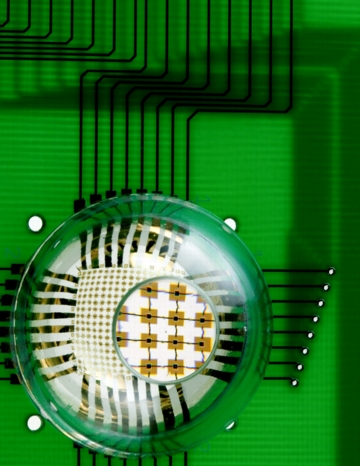Home > Press > Stretchable silicon camera next step to artificial retina
 |
| Photo courtesy John Rogers Photograph of the electronic eye camera after integration with a transparent hemispherical cap and a simple, single component imaging lens. |
Abstract:
By combining stretchable optoelectronics and biologically inspired design, scientists have created a remarkable imaging device, with a layout based on the human eye.
As reported in the Aug. 7 issue of the journal Nature, researchers at the University of Illinois and Northwestern University have developed a high-performance, hemispherical "eye" camera using an array of single-crystalline silicon detectors and electronics, configured in a stretchable, interconnected mesh.
Stretchable silicon camera next step to artificial retina
CHAMPAIGN, IL | Posted on August 6th, 2008 The work opens new possibilities for advanced camera design. It also foreshadows artificial retinas for bionic eyes similar in concept to those in the movie "Terminator" and other popular science fiction.
"Conformally wrapping surfaces with stretchable sheets of optoelectronics provides a practical route for integrating well-developed planar device technologies onto complex curvilinear objects," said John Rogers, the Flory-Founder Chair Professor of Materials Science and Engineering at Illinois, and corresponding author of the paper.
"This approach allows us to put electronics in places where we couldn't before," Rogers said. "We can now, for the first time, move device design beyond the flatland constraints of conventional wafer-based systems.
The camera's design is based on that of the human eye, which has a simple, single-element lens and a hemispherical detector. The camera integrates such a detector with a hemispherical cap and imaging lens, to yield a system with the overall size, shape and layout of the human eye.
To make the camera, the researchers begin by molding a thin rubber membrane in the shape of a hemisphere. The rubber membrane is then stretched with a specialized mechanical stage to form a flat drumhead.
Next, a prefabricated focal plane array and associated electronics - created by conventional planar processing - are transferred from a silicon wafer to the tensioned, drumhead membrane.
When the tension is released, the membrane returns to its original shape. This process compresses the focal plane array, causing specially designed electrical interconnects to delaminate from the rubber surface and form arcs, pinned on the ends by detector pixels. These deformations accommodate strains associated with the planar to hemispherical transformation, without stressing the silicon, as confirmed by mechanics modeling performed by researchers at Northwestern.
The array package is then transfer printed to a matching hemispherical glass substrate. Attaching a lens and connecting the camera to external electronics completes the assembly. The camera has the size and shape of a human eye.
Over the last 20 years, many research groups have pursued electronic eye systems of this general type, but none has achieved a working camera.
"Optics simulations and imaging studies show that these systems provide a much broader field of view, improved illumination uniformity and fewer aberrations than flat cameras with similar imaging lenses," said Rogers, who also is a researcher at the Beckman Institute and at the university's Frederick Seitz Materials Research Laboratory.
"Hemispherical detector arrays are also much better suited for use as retinal implants than flat detectors," Rogers said. "The ability to wrap high quality silicon devices onto complex surfaces and biological tissues adds very interesting and powerful capabilities to electronic and optoelectronic device design, with many new application possibilities."
Funding was provided by the National Science Foundation and the U.S. Department of Energy.
####
About University of Illinois at Urbana-Champaign
Illinois is a world leader in research, teaching, and public engagement, distinguished by the breadth of its programs, broad academic excellence, and internationally renowned faculty. Illinois alumni have earned Nobel and Pulitzer Prizes and Olympic medals, have orbited the earth, and lead international corporations.
For more information, please click here
Contacts:
James E. Kloeppel
Physical Sciences Editor
217-244-1073
John Rogers
217-244-4979
Copyright © University of Illinois at Urbana-Champaign
If you have a comment, please Contact us.Issuers of news releases, not 7th Wave, Inc. or Nanotechnology Now, are solely responsible for the accuracy of the content.
| Related News Press |
News and information
![]() Researchers develop molecular qubits that communicate at telecom frequencies October 3rd, 2025
Researchers develop molecular qubits that communicate at telecom frequencies October 3rd, 2025
![]() Next-generation quantum communication October 3rd, 2025
Next-generation quantum communication October 3rd, 2025
![]() "Nanoreactor" cage uses visible light for catalytic and ultra-selective cross-cycloadditions October 3rd, 2025
"Nanoreactor" cage uses visible light for catalytic and ultra-selective cross-cycloadditions October 3rd, 2025
Discoveries
![]() Researchers develop molecular qubits that communicate at telecom frequencies October 3rd, 2025
Researchers develop molecular qubits that communicate at telecom frequencies October 3rd, 2025
![]() Next-generation quantum communication October 3rd, 2025
Next-generation quantum communication October 3rd, 2025
![]() "Nanoreactor" cage uses visible light for catalytic and ultra-selective cross-cycloadditions October 3rd, 2025
"Nanoreactor" cage uses visible light for catalytic and ultra-selective cross-cycloadditions October 3rd, 2025
Announcements
![]() Rice membrane extracts lithium from brines with greater speed, less waste October 3rd, 2025
Rice membrane extracts lithium from brines with greater speed, less waste October 3rd, 2025
![]() Researchers develop molecular qubits that communicate at telecom frequencies October 3rd, 2025
Researchers develop molecular qubits that communicate at telecom frequencies October 3rd, 2025
![]() Next-generation quantum communication October 3rd, 2025
Next-generation quantum communication October 3rd, 2025
![]() "Nanoreactor" cage uses visible light for catalytic and ultra-selective cross-cycloadditions October 3rd, 2025
"Nanoreactor" cage uses visible light for catalytic and ultra-selective cross-cycloadditions October 3rd, 2025
|
|
||
|
|
||
| The latest news from around the world, FREE | ||
|
|
||
|
|
||
| Premium Products | ||
|
|
||
|
Only the news you want to read!
Learn More |
||
|
|
||
|
Full-service, expert consulting
Learn More |
||
|
|
||








